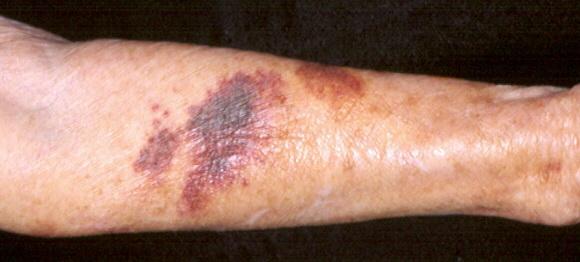Senile Purpura is a condition where purple bruises form recurrently on the forearms or legs. This is a benign condition affecting the elderly, and it usually develops after a minor trauma.
Faced with patches on your skin that looks like you have been badly bruised, although you are sure there hasn’t been any such incident? This could be an indication of senile purpura.
Read to find out more about senile purpura, to find out what it is, how it looks, what causes it. You will also read about factors that increase the risk of senile purpura and explore some precautions to deal with this condition.
Table of Contents
What is Senile Purpura?

Purpura is the discoloration of the skin due to rupturing of blood vessels, causing blood to seep into the tissues. Larger patches of purpura are called ecchymoses.
The condition results from the weakening of blood vessels and connective tissues, due to aging. The purple-red bruises are not caused by any bleeding disorder or deficiency of vitamins and minerals.
Senile purpura is also known by the following names:
- Actinic purpura
- Purpura senilis
- Solar purpura
- Bateman purpura – named after dermatologist Thomas Bateman, who first described the condition in 1818.
What Causes Senile Purpura?

The natural process of aging along with factors like environmental stress causes gradual changes in the skin. The layer of fat below the skin is depleted, and water retention ability is lost. The skin loses collagen and elasticity, and healing of wounds is delayed.
The oxygen formed by the reaction of ultraviolet rays on the skin, as well as those produced by the metabolic functions of the body, react with the lipids, proteins and nucleic acids, causing changes in their structure that gradually affect its functioning.
This damage due to oxidization is normally balanced by the natural antioxidants in the body. However, as time passes, the oxidative stress disrupts this balance, and the damage builds up to cause tissue aging.
Skin tissues become thin and fragile with increasing age. Exposure to ultraviolet radiation from the sun causes skin atrophy and results in fragile blood vessels.
Blood vessels close to the surface of the skin become prone to rupture, and even minor trauma can tear these vessels. This causes bleeding and red blood cells leak into the skin tissues, resulting in the formation of purple patches.
Senile purpura is different from thrombocytopenic purpura (that is caused due to platelet disorders), connective tissue disorders and vitamin C deficiency.
Thrombocytopenic purpura can be caused by idiopathic thrombocytopenic purpura, neonatal thrombocytopenia, or meningococcemia, which results in platelet disorders.
Nonthrombocytopenic purpura may develop due to factors like disorders in blood clotting, fragile blood vessels due to aging, amyloidosis, congenital cytomegalovirus, vasculitis, vitamin C deficiency, hemangioma or use of drugs that interfere with platelet functioning.
Senile purpura can be caused by the excess use of aspirin, warfarin, steroids or other medications known to thin the blood.
Other factors that may lead to senile purpura are diabetes and vascular disorders.
Brown discoloration that persists after the bruises have healed is the result of deposition of hemosiderin, a component of RBCs.
Symptoms Of Senile Purpura
Senile purpura is characterized by purple-red bruises on the skin, which gradually turns into a persistent yellow-brown colored patch due to iron accumulation.
The ecchymoses may form into irregular shapes and can be chronic or recurrent.
These may be about 1-4 cm in size with clearly defined margins.The patches are mostly found on the extensor surfaces of the arms, legs, and neck in older individuals.
The condition usually develops a few days after minor injury or trauma to the skin.Dermal tissues become thin, lose elasticity, tears easily, get pigmented, and atrophy.
While the condition usually lasts over 1-3 weeks, the brown pigmentation may take a few more weeks or even months before they disappear on their own.
Who Are Vulnerable To Senile Purpura?
Senile purpura mostly occurs in the older population, comprising of those above 50 years old.
The condition equally affects older men and women.
The occurrence increases with sun exposure and the effects tend to be more pronounced in individuals with fair skin type.
Use of blood thinners (anticoagulants) and corticosteroids can also increase your vulnerability to senile purpura.
Senile Purpura Diagnosis
Senile purpura is generally diagnosed by appearance.
Criteria for diagnosis include:
- Occurrence in individuals above 60 years of age, common in both men and women.
- Patches of 1-4 cm size on the skin in exposed areas of the arms and legs. These may appear on face and neck in some cases.
- Thin epidermis with reduced collagen
- Extravasation of blood into dermal tissue.
- Skin atrophy
Tests could be conducted for differential diagnosis, to help in ruling out other conditions. These include:
- Coagulation profile
- Differential blood count
- Urine test
- Skin culture
- Erythrocyte sedimentation rate (ESR) to identify inflammation from vascular disorders.
- Liver function tests to eliminate possibilities of liver inflammation
- Renal function tests
Treatment For Senile Purpura
Senile purpura heals typically by itself, and the blood that had seeped into the tissues is reabsorbed over time.
While it may look unpleasant, the condition is quite harmless and does not have any major consequences.
Hence, senile purpura usually does not require any treatment.
In most of the cases, people only need to be assured that senile purpura is a benign condition and it takes patience to let it heal gradually.
If senile purpura is caused by the use of certain medications, you may be advised to stop using them or maybe given prescribed an alternative.
Here are a few approaches you can adapt to deal efficiently with senile purpura.
1. Vitamin C
Vitamin C plays a significant role in the production of collagen. Collagen is an essential component found in the tendons, ligaments, and blood vessels. Insufficient amounts of vitamin C in the body could lead to the weakening of the blood vessels, bleed, and easy bruising.
It also possesses antioxidant properties and controls the deteriorating effects of aging, such as thinning and fragility of skin, and loss of collagen. It also combats oxidative stress in the body.
Purpura patches have been found to improve with vitamin C supplementation along with bioflavonoids.
Adequate supplement of vitamin C can reduce the appearance and control recurrence of purpura.
Natural dietary sources of vitamin C include bell pepper, papaya, gooseberry (amla), guava, berries and citrus fruits.
Besides these vitamin C supplements are also available, to ensure sufficient intake.
The potential of topical applications of vitamin C in treating senile purpura is an option that is being studied. These can deliver higher amounts of vitamin C to the affected area of the skin.
2. Citrus Bioflavonoids
Citrus bioflavonoids have antioxidant properties that help to deal with oxidative stress. Intake of citrus bioflavonoids is found to strengthen blood vessels and reduce purpura patches.
It controls inflammation, reduces swelling, improves the functioning of blood cells and leads to better blood circulation. These also help to enhance the absorption and action of vitamin C.
These bioflavonoids are derived from citrus fruits like orange, lemon, grapefruit, lime, and tangerine.
Bioflavonoids from citrus fruits include hesperidin, rutin, naringenin, eriocitrin, and diosmin.
These compounds reduce capillary permeability; improve the functioning of the lymphatic system, and fight oxidative stress due to ultraviolet rays of the sun.
3. Vitamin K & Senile Purpura
Vitamin K helps to control the negative effects of aging on the skin, thereby reducing the appearances of bruises. It also controls the blood leaking into the tissues, aids in clotting, and enhances collagen production.
Using a Vitamin K cream twice a day aids in breaking down and absorption of blood cells and quickens up healing.
Consuming green leafy vegetables, olive oil, sprouts, spring onion, broccoli, cabbage and dry prunes can boost levels of vitamin K in the body.
4. Topical Silicone
A small dose of silicon can improve the synthesis of collagen and improve the overall skin condition.
Silicone treatments have proven useful for various types of burns and ulcers. It also controls skin atrophy and loss of elastic nature.
Silicone is widely used for treating scar formations following trauma. Topical silicone can be applied to deal with the symptoms of senile purpura.
5. Arnica Montana
Arnica Montana has anti-inflammatory properties and controls bleeding. It can treat and reduce the formation of purpura patches.
It is used to effectively heal bruises and quickens the process. Arnica can be used to treat the condition where the blood vessels break and leak under the skin, causing discoloration.
The medication is derived from the flowers of the Arnica plant.
Both oral and topical formulations of arnica are available, in the form of tablets, gels, and lotions.
Individuals experiencing senile purpura could avoid foods that thin the blood, such as red wine and fatty fish, which also lower the platelet count.
Some individuals with senile purpura may experience frequent skin tearing. This condition requires medical assistance.
Precautions
Aging is an inevitable biological process, and its effects cannot be entirely prevented.
Nevertheless, here are a few things you can do:
- Avoid long-term exposure to the sun to avoid damaging the skin. Be sure to use protection such as sunscreens, hats and appropriate clothing when you go out. This may also help to control recurrence of senile purpura.
- Avoid trauma to the affected area of the skin. Refrain from activities like rubbing or pricking, which can aggravate the condition.
- Control the use of medications like aspirin and steroids, due to their effects that we had discussed earlier.
- You may consider taking supplements of antioxidants, bioflavonoid, and vitamins that protect the skin. These help to restore collagen in the skin.
- Bruises and tearing of the skin can be controlled to an extent by using skin moisturizers.
- Take adequate precaution to avoid falls, bumps, and injuries.





